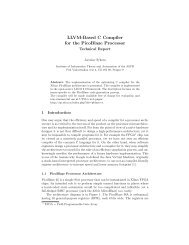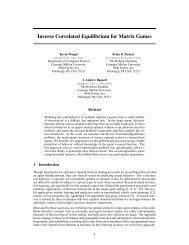decision making with multiple imperfect decision makers - Institute of ...
decision making with multiple imperfect decision makers - Institute of ...
decision making with multiple imperfect decision makers - Institute of ...
Create successful ePaper yourself
Turn your PDF publications into a flip-book with our unique Google optimized e-Paper software.
4 ImplementationThe above procedures have been implemented <strong>with</strong>in the AISoy1 robot environment(http://www.aisoy.es). Some <strong>of</strong> the details <strong>of</strong> the model implemented are described next, <strong>with</strong> codedeveloped in C++ over Linux.The set A includes the robot’s actions which include cry, tell a joke, ask for being recharged, complain,talk, sing, argue, ask for playing, ask for help and do nothing. On the user’s side, set B, therobot is able to detect several agent’s actions, some <strong>of</strong> them in a probabilistic way. Among them,the robot detects hug, hit, shout, speak, being recharged, play, being touched, stroke or no action.Regarding the environment (set E), the bot may recognize contextual issues concerning the presence<strong>of</strong> noise or music, the level <strong>of</strong> darkness, the temperature, or its inclination. To do so, the bot hasseveral sensors including a camera to detect objects or persons <strong>with</strong>in a scene, as well as the lightintensity; a microphone used to recognize when the user talks and understand what he says, througha natural language processing component; some touch sensors, to interpret when it has been touchedor hugged or hit; an inclination sensor so as to know when it is lying down or not; and a temperaturesensor. The information provided by these sensors is used by the bot to infer the user’s actions andenvironmental states. Some are based on simple deterministic rules; for example, the hit action isinterpreted through a detection in a touch sensor and a variation in the inclination sensor. Others arebased on probabilistic rules, like those involving voice recognition and processing.The basic forecasting models (environment, user, classical conditioning) are Markov chains and welearn about their transition probabilities based on matrix beta models, see [20]. For expected utilitycomputations and point forecasts we summarize the corresponding row-wise Dirichlet distributionsthrough their means. Learning about probability models is done through Bayesian model averaging,as in [9].The bot aims at satisfying four objectives, which, as in [14], are ordered in hierarchical order <strong>of</strong>importance. They go from a primary security objective, in which the bot cares mainly for its survivaland security (in terms <strong>of</strong> not being hit, having a sufficient energy level, and being at the righttemperature), to higher objective levels in relation <strong>with</strong> a social empathy layer, once basic objectivesare sufficiently covered, in relation <strong>with</strong> social interests <strong>of</strong> the bot. Weights reflect the importance<strong>of</strong> the objectives and component utility functions reflect the aim <strong>of</strong> fulfilling as quickly as possiblethe primary objectives, up to a certain level. Emotion implementations are based on [7], who comparedifferent appraisal models to obtain the intensity <strong>of</strong> an emotion. We use four basic emotions(joy, sadness, hope and fear), which are then combined to obtain more complex emotions. Emotionsevolve as Dynamic Linear Models, as in [23].The model is implemented in a synchronous mode. Sensors are read at fixed times (<strong>with</strong> differenttimings for various sensors). When relevant events are detected, the basic information processingand <strong>decision</strong> <strong>making</strong> loop is shot. However, as mentioned it is managed by exception in that ifexceptions to standard behavior occur, the loop is open to interventions through various threads.We plan only one step ahead and choose the action <strong>with</strong> probabilities proportional to the computedexpected utilities. Memory is limited to the two previous instants.5 DiscussionWe have described a model to control the behavior <strong>of</strong> an agent in front <strong>of</strong> an intelligent adversary. Itis multi-attribute <strong>decision</strong> analytic at its core, but it incorporates forecasting models <strong>of</strong> the adversary(Adversarial Risk Analysis) and emotion-based behavior (Affective Decision Making). This wasmotivated by our interest in improving the user’s experience interacting <strong>with</strong> a bot [2], [12] and[15]. We believe though that this model may find many other potential applications in fields likeinterface design, e-learning, entertainment or therapeutical devices.The model should be extended to a case in which the agent interacts <strong>with</strong> several users, througha process <strong>of</strong> identification. It could also be extended to a case in which there are several agents,possibly cooperating or competing, depending on their emotional state. Dealing <strong>with</strong> the possibility<strong>of</strong> learning about new user actions, based on repeated readings, and, consequently, augmenting theset B is another challenging problem. Finally, we have shown what is termed a 0-level ARA analysis.We could try to undertake higher ARA levels in modeling the performance <strong>of</strong> adversaries.5







